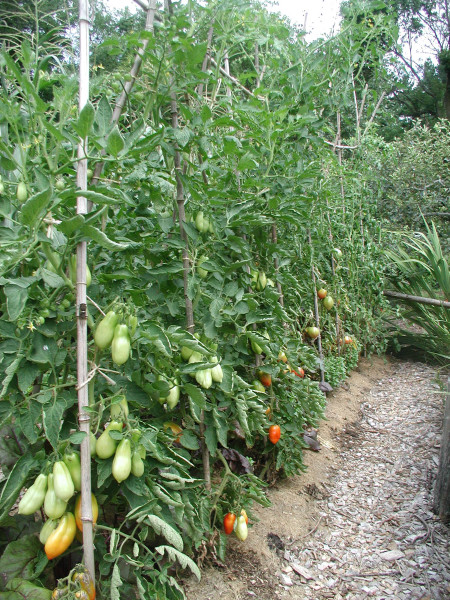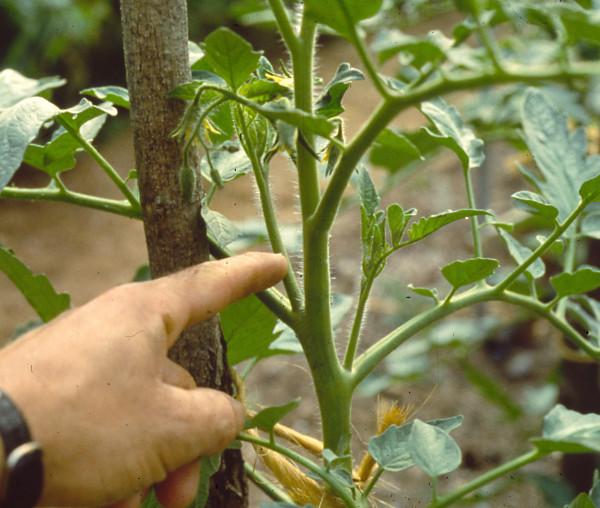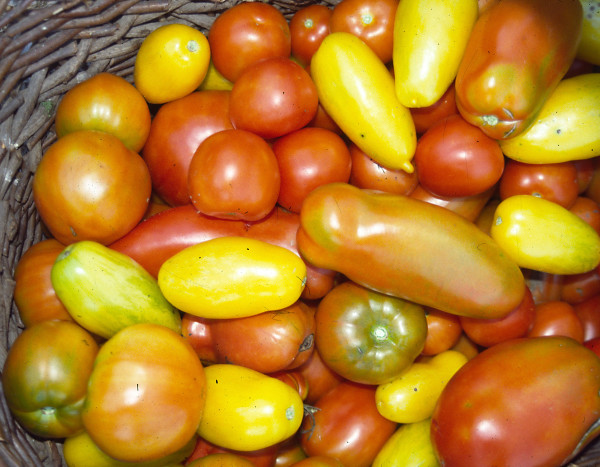Picture this: You step outside your old house, grab a tomato from one of your plants, and sink your teeth into the juicy flesh bursting with flavor—the same delicious taste gardeners a generation ago might have enjoyed.

For greatest yields, and to pack the most varieties into a small space, prune tomatoes and train them to stakes.
Great old-fashioned flavor is easily found in heirloom tomatoes, a loose term given to tomato varieties whose seeds have been passed on for generations within a family, or to tomato plants originating before 1940. Why 1940? Because that was when modern, hybrid tomatoes began appearing in markets and seed packets.
Hybrid tomatoes, which make up the bulk of what is grown and sold today, result from the mating of selected parents, and can’t be propogated from collected seeds. Hybrids typically yield a tomato that is disease-resistant, firm, rich in color, and, above all, appealing to the eye—perfect for a grocer’s produce section, but often lacking in flavor. Heirloom varieties are open-pollinated, which means seeds are taken out of this year’s fruit and saved to grow next year’s tomatoes. This process will bear the same fruits as this year’s—and that’s how these varieties have been passed on from generation to generation. But being able to save seeds from one year to the next is not the main reason that I and many other gardeners grow heirloom tomatoes—we do it for the flavor. Plus, tomatoes of any stripe are easy to grow. Given a sunny area (six or more hours of direct summer sunlight) and soil that isn’t home to standing water, tomatoes grow almost like weeds.
Start from Seeds
Tomatoes are a long-season crop, so in most areas, small transplants, which have been already growing for a few weeks indoors or in a greenhouse, are put in the garden once the weather warms. Many nurseries either won’t have heirloom plants or won’t have the ones you favor, in which case growing your own transplants is the way to go. Acquire seeds by buying, begging, or borrowing (literally, because you can extract the seeds and return them after you grow the tomatoes) from varieties you like. Besides seed companies, neighbors, and friends, you might also get your seeds from any heirloom tomato you’ve taken a bite from. Just scoop out some seeds, mix with water, and let the mix ferment. After a few days, rinse, strain, and dry the seeds on a paper towel in a warm spot, and you’re on your way to historic tomato heaven.

When training tomatoes to a single stem on a stake, remove any shoots growing where a leaf meets the main stem.
Timing is critical, so plant each year’s tomato seeds indoors four weeks before the average date for the last frost in your area. (Two reliable sources for frost dates are your local Cooperative Extension Office and victoryseeds.com/frost.) Fill a shallow container that has drainage holes in the bottom with potting soil—not garden soil—and set the seeds into the soil about 1/4″ deep. Place the container in a pan of water, and once the potting soil has soaked up water, cover the container and move it somewhere warm, ideally about 75 F. (Light is unnecessary at this point.)
Seeds will poke through the soil within a few days, at which point the seedlings do best with slightly cooler temperatures and as much light as possible. That light can be artificial, as long as it’s fluorescent (incandescent lights give off too much heat) and the tops of the plants are kept no more than a few inches below the bulbs. An unobstructed, south-facing window also is ideal. The transplants will most likely bend toward the natural light. Gently brushing or shaking the seedlings keeps them stocky and healthy, and rotating the plants in windows every couple of days keeps both sides illuminated.
Planting in the Garden
Around the date of your last killing frost, the plants are ready to transition outdoors. Acclimate them to more intense light, cooler temperatures, and the drying effect of winds by first moving them to a protected area, always bringing them back indoors if freezing temperatures threaten. About a week after the last frost date, plant the tomatoes in the ground, which involves nothing more than making a hole large enough to accommodate the root-ball of the small plant, watering the open hole and root-ball, and then backfilling and firming the soil around the plant.

Heirloom tomatoes come in all shapes, sizes, colors, and flavors.
Tomatoes grow as nonclinging vines that, unfettered, will sprawl all over the ground. You can certainly grow them that way, as long as you give each plant sufficient space, about 3′ from any neighboring plants. With plants as close as 18″ apart, you can train them to a single stem, which is tied to a stake to bring the plant skyward. With staking, you get less fruit per plant but more fruit per ground area, plus cleaner and slightly earlier fruits. Tie the main stem to a sturdy stake, such as a metal electrical conduit or a 2×2 wood stake. Staking requires weekly pruning or pulling off any shoots (called “suckers”) that try to grow at the juncture just above where a leaf meets the main stem. In between the extremes of staking and sprawling are other systems of training tomatoes, everything from heavy wire cages to fences with vines pruned occasionally to keep them within bounds.
Although plants typically start off slowly early in the season, one day you’ll look and see that the plants are suddenly growing rampantly. If you plan to pinch or prune the growing plants, start doing so before the plants grow too much so large stems don’t need removal.
Harvest Time
Depending on the variety and the growing season, you’ll taste your first heirloom tomatoes of the season anywhere from 65 to 95 days after you set out the transplants. You want to wait until a tomato is ripe before harvesting it, but that point may not be as obvious with some heirloom varieties as with most hybrids. A number of varieties—Black from Tula, for example—remain green on their shoulders when the rest of the fruit is fully colored, ripe, and ready to harvest. Pick the fruit when the bottom is thoroughly ripe. Don’t be put off by lumpiness or “cat-facing” (scarring) of ripe fruits, either. Heirloom tomatoes aren’t here to win beauty contests—just to offer superb flavor, as they did in years past.
For more tips on growing your own fruits and vegetables, check out this article on how to create your own cutting garden.







